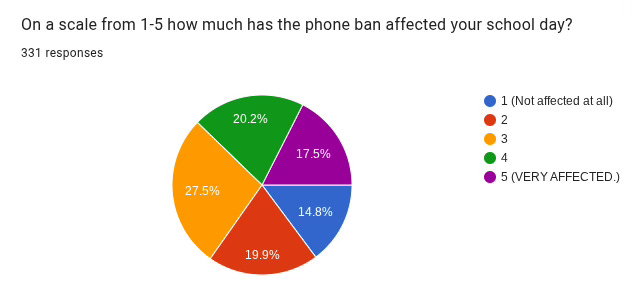Students Speak Out About Cellphone Ban
Largest percentage of surveyed students say the ban has had a significant impact on their school lives.
By Willow Martin
Junior, CVU
Hawk’s Nest Staff Writer
The recent phone ban implemented at CVU has sparked a wide range of reactions and conversations from both the student body and faculty.
Under new guidelines, teachers may confiscate a student’s phone if it is seen out during school hours (8:45 a.m.–3:20 p.m.), returning it at the end of the day. While intended to reduce distractions, the policy has stirred frustration among students who feel it undermines their sense of safety and autonomy.
A survey conducted by The Hawks’ Nest received over three hundred student responses. A majority of students (65 percent) said it had affected their school life moderately to severely with the highest percentage (27.7 percent) reporting that the phone ban affected their school day at a three on a scale of one to five. The value of one represented “the phone ban does not affect my school day at all,” and a five “the phone ban efforts my daily life consistently.” The high results mean that the policy has had a notable impact on a significant portion of the student body when it comes to everyday life.
Many students expressed that the ban limits their ability to communicate in emergencies. One anonymous student said, “I am extremely upset with this level of disregard and I feel very unsafe knowing I can’t text my family in case of an emergency. I have lost my whole sense of security in school.” Another added, “I think this is disrespectful to our school and the students in it...We are treated like kindergarteners.
Some students pointed to specific incidents that highlighted the ban’s rigidity. Marin Bergeson ‘27 shared, “At 3:19 p.m. I witnessed a teacher taking the phone of someone walking past in the hallway. They had it in their back pocket and as the teacher walked away, the bell rang. This student now has to go through the painstaking process of getting their phone back because they had it on their person fifteen seconds before school technically ended.”
Students’ comments also reflect a desire to have more input in decisions that directly affects their daily lives. An anonymous student shared, “The majority of the student population and some faculty members were given no choice on the phone ban. I really am sad to see how this played out. And would have loved to have more of a voice.”
Another student added, “The people who banned phones at CVU were out of touch. Phones are tools we need, just like books and pencils. By not adapting and banning them, the school is showing they don’t trust us and are stuck in the past.”
Despite the concerns, some students still support the phone ban, noting that it may benefit overall focus and classroom management. Arthur Edwards ‘28 shared a more positive experience, explaining that the policy “has been structured much better than I thought. I haven’t found it to give me any problems. Oddly enough, I might even say I like it knowing that there’s less people mindlessly scrolling their lives away.”
Edwards added that while he was initially worried about losing the ability to contact his parents, “since they’re put in a pouch we still have them to contact people after school. My main concern was not having access to tell my parents if I needed to get picked up or if the bus was late.”
One student pointed out, “They didn’t think about the people who never abused their phones and were always respectful to their teachers.” While the phone ban has stirred strong feelings at CVU, it isn’t just a local decision.
According to the Vermont General Assembly, Vermont schools will be required by law to prohibit cellphone use during school hours as of the 2026-2027 school year.
CVU is among one of the earlier schools to fully implement the guidelines, which means both students and staff are adjusting earlier than some. Whether the change ultimately improves learning or remains a frustration among students, the issue has opened a larger conversation about safety, trust, and the role of technology in education.
(Editor’s note: This story is being reprinted today with permission from the October issue of student-led newspaper The Hawk’s Nest. The full paper can be downloaded or read by clicking the .pdf link below.)


